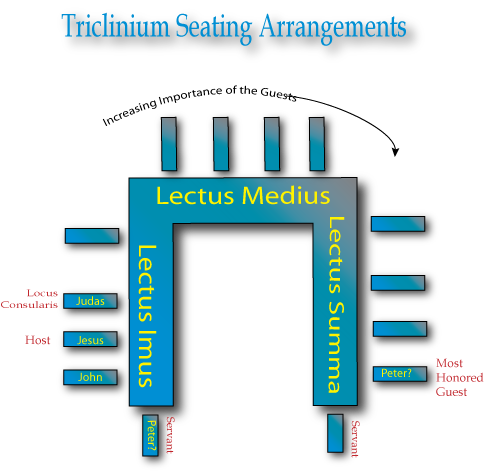THE ARRANGEMENT OF THE TABLE OF THE LAST SUPPER

According to the traditions of a formal symposium style banquet, the common ritual of a special feast in the 1st century AD, the banqueters gathered around a U-shaped table or reclined on a U-shaped platform. This Greek/Roman style banquet room was called a triclinium, and the banqueters reclined on couches which radiated out from the banquet table. The host always occupied the Lectus imus, the table to the left of the inverted U. This is where Bible scholars believe Jesus placed Himself at the Last Supper where He took the position of the Host. According to Scripture the arrangement would have been:
- Jesus in His position as Host, at the second position at the Lectus imus
- Judas, in the place of the locus consularis (chief consulor), who as the honored guest is the first to receive the "sop," seated to Jesus' left (see John 13:26)
- John, on Jesus' right (actually John and Jesus were sharing the same couch since the Gospel of John records that John leaned against Jesus' chest, which places him to Jesus' right (see John 13:25)
Slaves stood to eat while freeborn men reclined. For Jews in the 1st century AD it was the custom to eat reclining as a free-born man by supporting oneself with the left arm and eating with the right hand. According to the formal plan of a banquet after the seats on either side of the host, the higher positions of rank increased to the left of the host. The table to the farthest left of the host, the Lectus suma, held the most important invited guests who had a good vantage point for conversing with the host who was reclining on his left arm. There were also two stools at the end of each arm of the U where the servants sat who assisted in the ritual hand washing during the meal and in serving and passing the food and the four communal wine cups.
Most scholars think Peter was placed in position of the most honored guest at the far left of the Lectus summa, but this theory contradicts Jesus' teaching on humility and service, the last shall come first and the first last (see Matthew 19:30; 20:16; Mark 10:31; Luke 13:30; and a similar teaching in Luke 14:8-9), which was a teaching Jesus may have been demonstrating visually that night by placing John, the youngest and therefore the least of the Apostles, in the place of honor on His right (John 13:23-25). Jesus also illustrated the teaching of "the first shall come last" in His washing of the Apostles' feet, taking on the role of a servant Himself, to demonstrate that they must be servants who serve with love and humility as His emissaries of the New Covenant to the world (John 13:12-16). It would have been more in line with Jesus teaching that night if Peter, the foremost of the Apostles, was occupying the small seat of the servant at the end of the table, giving him direct access to ask John (John 13:23-24) "Who is it who will betray the Master"? It may be a tradition which was inaugurated at this sacred meal that one of the oldest titles for the Bishop of Rome which was applied to Peter and all his successors is "Servant of the servants of Christ."
Michal Hunt Copyright © 2005 Agape Bible Study. Permissions All Rights Reserved.
